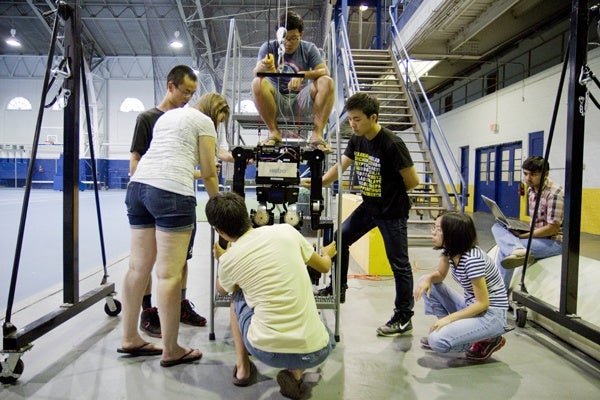Penn, Drexel researchers compete in Pentagon’s Robotics Challenge
In case of a nuclear disaster, what if we could send in radiation-immune robots instead of human relief workers?
That’s the thinking behind the DARPA Robotics Challenge, sponsored by the Pentagon’s research and development wing.
Teams from both Drexel and Penn are among six semi-finalists in the contest to build the baddest rescue robot. In December, their robots have to run an obstacle course in which they climb ladders, walk through rubble and even drive cars.
The finals aren’t until 2014, when the team with the best bot will win $2 million. But the competition is tough—two teams from NASA also are in the running.
Drexel’s entry, “Hubo,” is about the size of a 10-year-old boy. It’s a humanoid—with arms and legs like people.
Paul Oh, who runs Drexel’s autonomous systems lab, has been working on Hubo for years. But for this Robotics Challenge, a team of students from Drexel and nine other schools, including Swarthmore and the University of Delaware, are making Hubo bigger and stronger so it can tough it out in a nuclear disaster zone.
Hubo can already perform all of the tasks it will face on the obstacle course. The challenge now is getting it to do those things well.
The students have Hubo practice on a realistic set—complete with upended barrels, rusty walls and debris—that they commissioned a Broadway set designer to create.
‘It doesn’t really feel like work’
Drexel’s Daniel Lofaro, one of the lead researchers on the DARPA project, said they wanted to make it look realistic in order to train Hubo’s vision algorithms to work well in grimy, dimly lit environments.
Drexel grad student Robert Ellenberg said he spends a good chunk of his time fine-tuning Hubo. But, “when you’re working on a project like this, in a field like this,” he said, “often it doesn’t really feel like work. Sometimes, it’s almost like we’re getting paid to play.
Ellenberg specializes in humanoid robotics, and he said that the DARPA challenge could propel the field forward.
“This project, and from a larger perspective, this scenario—the disaster recovery scenario—will be a big step forward for humanoid robotics,” he said.
DARPA doesn’t require the teams to build a humanoid, but it’s hard to get a robot on wheels to climb up a ladder. It makes sense to replace human relief workers with robots that are built to work like humans.
But while humanoids are a perfect fit in theory, programming them to work as well as humans is no easy feat.
The human brain is far more complex than any computer, and the human body is much more compliant. Our inner ears and the pads of our feet are far more powerful than any sensor you could attach to a robot.
“You can kind of walk like a robot if you put on ski boots”—and a blindfold, Lofaro said.
Hubo can walk on two feet, but in order to keep its balance on uneven ground, it sometimes walks all fours instead.
Robots still need a hand from humans
All the robots in the DARPA challenge are semi-autonomous, which means that they can do some things independently and others with human direction.
So while Hubo can depend on a student in a control room to tell it what a valve is, it will have to turn the valve by itself.
Getting any kind of robot to perform well in a disaster situation is quite a big step.
Professor Dan Lee, who leads Penn’s team, said that robots are best at performing specific tasks in a very controlled environment.
“Here we’re having a challenge where the robots have to go into a completely unknown environment,” he said. “You have lots of debris, a lot of uncertainty in the environment. And these are places where humans have a difficult time.”
Penn has partnered with Virginia Tech, and their robot is humanoid as well. It’s named after the Nordic god of thunder, Thor.
According to Lee, all the technology required to build a robo-rescuer exists. Researchers have gotten robots to walk, climb and lift. But bringing all of that research and knowledge together will be a big achievement.
“The level of difficulty they’re asking for in all the tasks is incredible,” Lee said. “Each one of these tasks could be a cutting-edge Ph.D. thesis.”
Encouraging creative thought
The previous DARPA-funded challenge was to build a driverless vehicle. Stanford University placed first and continued to work on the technology even after the competition concluded in 2005. Its collaboration with Google led to the development of Google’s driverless car, which completed 300,000 autonomous-driving miles, accident-free, last year.
More than anything, Lee said, these sorts of challenges encourage innovation. “These challenges spur creative thought,” he said. “They ask, ‘Can we make a big leap?'”
Regardless of who wins, Lee said, the research that all the competitors will generate during the competition will benefit the larger scientific community.
Both Penn and Drexel have made their work open source—anyone can access it online.
“This is, after all, science,” Lee said. “We don’t see it as a purely monetary competition.”
WHYY is your source for fact-based, in-depth journalism and information. As a nonprofit organization, we rely on financial support from readers like you. Please give today.










